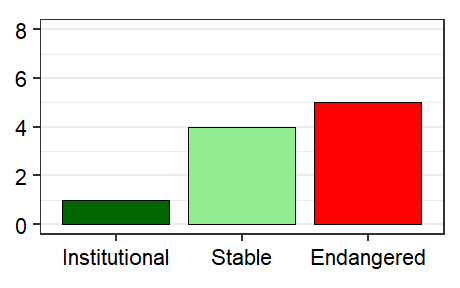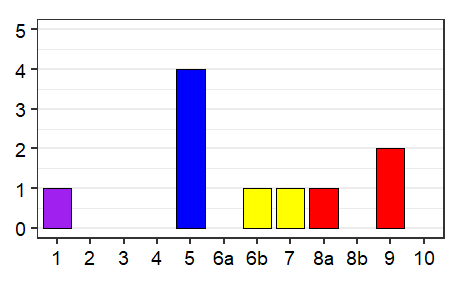HN
Honduras
Summary
- Official Name
- Population
- 9,546,000
- Principal Languages
- Spanish
- Literacy Rate
- 87% (2018 UNESCO)
- International Conventions
- CDE (1960), CPPDCE (2006), CSICH (2012), ICCPR (1966), (), UNCRPD (2006), UNDRIP (2007)
- General References
- Campbell 1997, Campbell and Oltrogge 1980, Oltrogge 1977, Rivas 1993
- Deaf Population
- 18,000–70,000
- Language Counts
- The number of established languages listed for Honduras is 10. All are living languages. Of these, 8 are indigenous and 2 are non-indigenous. Furthermore, 1 is institutional, 4 are developing, 2 are in trouble, and 3 are dying. Also listed are 2 unestablished languages.
Languages
- Arabic, South Levantine Spoken ajp
- Users: 32,000 in Honduras (2021 Joshua Project), based on ethnicity. Status: Unestablished. Classification: Afro-Asiatic, Semitic, Central, South, Arabic
- Armenian, Western hyw
- Users: 1,300 in Honduras (Johnstone and Mandryk 2001). Status: Unestablished. Classification: Indo-European, Armenian
- Ch’orti’ caa
- Copán department: along Guatemala border. Users: No known L1 speakers in Honduras. Ethnic population: 33,300 (2013 census). Status: 9 (Dormant). Classification: Mayan, Yucatecan-Core Mayan, Core Mayan, Cholan-Tzeltalan, Cholan, Chorti-Cholti
- Chinese, Yue yue
- Tegucigalpa. Users: 1,000 in Honduras (1999). Status: Unestablished. Classification: Sino-Tibetan, Chinese
- English eng
- Islas de la Bahía department: large cities along north mainland coast. Users: 9,000 in Honduras (2015 J. Leclerc). Also 13,000 speakers of Bay Island Creole English (2015 J. Leclerc). Status: 5* (Dispersed). Alternate Names: Inglés Classification: Indo-European, Germanic, West, English
- Garifuna cab
- Atlántida and Colón departments; Cortes department: north coast between Masca and Plaplaya in Gracias a Dios department; Islas de la Bahía (Roatan island) department; cities: La Ceiba, Puerto Cortés, San Pedro Sula, and Tegucigalpa; 37 villages. Users: 43,100 in Honduras (2013 census), based on ethnicity. 100 monolinguals. Ethnic population: 100,000 (2021 J. Leclerc). Total users in all countries: 119,400. Status: 6b (Threatened). Alternate Names: Black Carib, Caribe, Central American Carib, Garínagu, Karif Autonym: Garífuna Classification: Maipurean, Northern, Maritime, Ta-Maipurean, Iñeri
- Honduran Sign Language hds
- Scattered. Users: 40,000 (2021 DBS/DOOR/SIL). Estimated 30,000–60,000 deaf signers, assuming 0.3%–0.6% of the total population. Other estimates: 34,800 (2008 WFD), 18,000–70,000 (Williams 2010:5). Status: 5 (Developing). Recognized language (2013, Decreto no. 321-2013), Recognizes LESHO as a means of communication for deaf and the general population, provides for use in deaf education, training of interpreters and provision of interpreters for official government communications. Alternate Names: Honduras Sign Language, LESHO, Lengua de Señas Hondureñas, Lengua de señas Hondureña Classification: Sign language, Deaf community sign language
- Lenca len
- Comayagua, Francisco Morazán, Intibucá, La Paz, Lempira, and Valle departments. Users: No known L1 speakers. Last fluent speaker probably died by the 1970s (Campbell et al 1978). Some semi-speakers (Adelaar 2007). Ethnic population: 454,000 (2013 census). Status: 9 (Dormant). Alternate Names: Honduran Lenca, Lenka Classification: Lencan
- Mayangna yan
- Colón department: southeast corner; Gracias a Dios and Olancho departments: between Patuca and Wanki rivers. Users: 700 in Honduras (1997 SIL). Ethnic population: 2,690 (2013 census). Status: 5 (Developing). Alternate Names: Sumu, Tawahka Classification: Misumalpan
- Mískito miq
- Colón department; Gracias a Dios and Olancho departments, south, Coco river watershed; coastal area, and northwest from Puerto Lempira. Users: 29,000 in Honduras (Rivas 1993). Ethnic population: 80,000 (2013 census). Status: 5 (Developing). Alternate Names: Marquito, Mosquito, Mískitu, Mísquito Classification: Misumalpan
- Pech pay
- Colón department: near Caribbean coast; Olancho department: Dulce Nombre de Culmi and Catamacas municipalities. Users: 300 (Yasugi 2007). Ethnic population: 6,020 (2013 census). Status: 8a (Moribund). Alternate Names: Paya, Pesh, Seco Classification: Chibchan, Chibchan B
- Spanish spa
- Users: 9,453,000 in Honduras, all users. L1 users: 9,330,000 in Honduras (Instituto Cervantes 2021). L2 users: 123,000 (Instituto Cervantes 2021). Status: 1 (National). Statutory national language (1982, Constitution, Article 6). Alternate Names: Castellano, Español Classification: Indo-European, Italic, Romance, Italo-Western, Western, Gallo-Iberian, Ibero-Romance, West Iberian, Castilian
- Tol jic
- Francisco Morazán department: Montaña de la Flor and Yoro. Users: 300 (Yasugi 2007). Ethnic population: 19,000 (2013 census). Status: 7 (Shifting). Alternate Names: Tolpan, Tolupan, Torrupan, “Jicaque” (pej.), “Xicaque” (pej.) Autonym: Tol Classification: Jicaquean
Languages by Status
Spanish
[spa] 1 (National). Statutory national language (1982, Constitution, Article 6). 9,453,000 in Honduras, all users. L1 users: 9,330,000 in Honduras (Instituto Cervantes 2021). L2 users: 123,000 (Instituto Cervantes 2021).
English
[eng] 5* (Dispersed). 9,000 in Honduras (2015 J. Leclerc). Also 13,000 speakers of Bay Island Creole English (2015 J. Leclerc).
Honduran Sign Language
[hds] 5 (Developing). Recognized language (2013, Decreto no. 321-2013), Recognizes LESHO as a means of communication for deaf and the general population, provides for use in deaf education, training of interpreters and provision of interpreters for official government communications. 40,000 (2021 DBS/DOOR/SIL). Estimated 30,000–60,000 deaf signers, assuming 0.3%–0.6% of the total population. Other estimates: 34,800 (2008 WFD), 18,000–70,000 (Williams 2010:5).
Mayangna
[yan] 5 (Developing). 700 in Honduras (1997 SIL). Ethnic population: 2,690 (2013 census).
Mískito
[miq] 5 (Developing). 29,000 in Honduras (Rivas 1993). Ethnic population: 80,000 (2013 census).
Garifuna
[cab] 6b (Threatened). 43,100 in Honduras (2013 census), based on ethnicity. 100 monolinguals. Ethnic population: 100,000 (2021 J. Leclerc). Total users in all countries: 119,400.
Tol
[jic] 7 (Shifting). 300 (Yasugi 2007). Ethnic population: 19,000 (2013 census).
Pech
[pay] 8a (Moribund). 300 (Yasugi 2007). Ethnic population: 6,020 (2013 census).
Graphs
Language Vitality Profile

Full explanation
Language Status Profile

Full explanation
